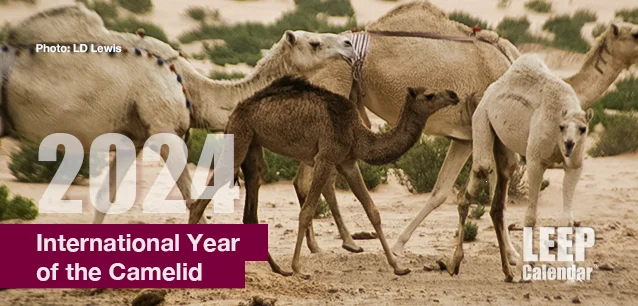 AD
AD
Today is: December 04
Scroll to explore events active on this date.
Additional Events on LEEP
LEEP INK FEATURES

August? Absolutely!
In August, we live through the Dog Days of Summer. It's hot and often humid, and those who can leave for better climates do. Down south, winter is in full force. August is also known as "the ...

In The Heat of July: July 2025 Events
Is it hot enough (or cold enough if you're below the equator) for you yet? There is actually a day for that! Like every month, I pick a diverse collection of events you may or may not know about. This ...

May Blooms: Events in May 2025
Along with October, May is one of the most densely packed months of the year. It's before the summer humidity and the last whole month of the school year. The weather is warming in t...
About the International Year of the Camelid
Ends: Dec 31, 2024
DESCRIPTION:
2024 is the United Nations International Year of the Camelid.
Camelids are a family of mammals that includes several species: camel, llama, alpaca, guanaco, and vicuña. These animals are native to the arid regions of South America and parts of Asia and have been domesticated for various purposes for thousands of years.
Camelids are known for their unique physical characteristics, which allow them to thrive in harsh and arid environments. Some key features of camelids include:
Humps: Camels are most notable for their distinctive humps, made of fat stores. These humps enable them to store energy and water and survive in extreme desert conditions. Llamas, alpacas, guanacos, and vicuñas, on the other hand, do not have humps.
Long Necks: Camelids have long, slender necks that are well-adapted for browsing vegetation in their native habitats.
Split Upper Lip: Their upper lips are split, allowing them to selectively feed on vegetation without consuming excessive amounts of thorny or spiky plants.
Thick Fur: Many camelids have thick fur that provides insulation against the cold and protects them from extreme temperatures.
Each species within the camelid family has its unique characteristics and uses:
Camels: Camels are primarily found in the Middle East and Central Asia. The two main species are the dromedary camel, with a single hump, and the Bactrian camel, with two humps. Camels are used for transportation, milk, meat, and wool.
Llamas: Llamas are domesticated camelids found in the Andean region of South America. They are larger than alpacas and have been bred for their wool and meat and as pack animals. Llamas are also used in some areas for guarding livestock due to their alert and protective nature.
Alpacas: Alpacas are smaller and more delicate than llamas and are selectively bred for their soft and luxurious coats. Alpaca wool is highly valued for its warmth, fineness, and hypoallergenic properties.
Guanacos and Vicuñas: Guanacos and vicuñas are wild camelid species found in South America. Guanacos are more robust, while vicuñas are more petite and highly prized for their fine wool. Both species are protected and are known for their graceful appearance.
In addition to their uses for transportation, fiber, meat, and milk, camelids play significant cultural and ecological roles in their native regions. They have adapted to survive in challenging environments and have become integral to the livelihoods and traditions of the communities that have relied on them for generations.
VIDEOS
SUPPORTING DOCUMENTS
Currently, this event does not have supporting documents.
ADDITIONAL IMAGES
Currently, this event does not have supporting images.
Where would you like to go now?
 AD
AD


/footer-logo.svg)
